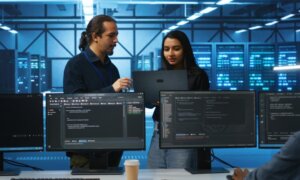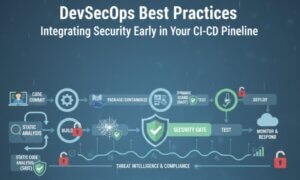In API Security, two critical vulnerabilities often confuse developers and security professionals alike: Broken Object Level Authorization (BOLA) and Broken Object Property Level Authorization (BOPLA). While both relate to authorization issues in APIs, they affect applications in distinct ways. Understanding the nuances between these vulnerabilities is crucial for securing APIs, especially in complex environments like microservices, GraphQL, and mobile applications.
In this blog, we will break down what BOLA and BOPLA mean, how they differ, and why addressing both is essential for robust API security.
-Book Your FREE Security Consultation Today!
Table of Contents
What is BOLA?
Broken Object Level Authorization (BOLA), also known as Insecure Direct Object References (IDOR), occurs when an API does not properly enforce authorization checks before allowing access to an object based on user-supplied input, such as an ID.
Example Scenario:
A user sends a GET request:
GET /api/users/12345
If the application does not verify whether the requesting user is authorized to access user ID 12345, any authenticated user might be able to view or modify someone else’s data simply by changing the ID.
Real-World Impact:
Unauthorized data access
Data tampering or deletion
Privilege escalation
What is BOPLA?
Broken Object Property Level Authorization (BOPLA) is a more granular vulnerability where the application fails to enforce authorization rules for specific properties or fields of an object. Even if the object-level access is correctly implemented, unauthorized users might still manipulate or access individual attributes within that object.
Example Scenario:
A user sends a PUT request:
PUT /api/users/12345
{
"role": "admin",
"email": "user@example.com"
}
Even if the user is allowed to update their own profile (user ID 12345), they should not be able to change sensitive properties like role. If the API does not enforce field-level authorization, the user can exploit this to elevate their privileges.
Real-World Impact:
Unauthorized access to sensitive fields
Role escalation
Data integrity issues
Key Differences Between BOLA and BOPLA
-Click to find out how to identify and fix BOLA vulnerabilities in your APIs
| Feature | BOLA | BOPLA |
|---|---|---|
| Scope of Authorization | Object-level | Property/Field-level |
| Common Attack Vector | ID manipulation in URL | JSON body manipulation |
| Example Exploit | Accessing another user’s record | Changing one’s role to admin |
| Risk Category | Horizontal and Vertical privilege escalation | Fine-grained access control violations |
| Mitigation | Enforce object-level permissions | Apply field-level access control |
Why BOPLA Is Gaining Attention
With the increasing adoption of GraphQL, mobile APIs, and rich client-side apps, developers expose more detailed data schemas through APIs. GraphQL, in particular, allows clients to request specific fields of objects, making field-level authorization critical. BOPLA vulnerabilities become more common in such setups, where even authorized users can misuse exposed fields.
Additionally, modern API security testing tools are starting to incorporate automated checks for BOPLA, recognizing its growing relevance.
How to Identify BOLA and BOPLA Vulnerabilities
Identifying BOLA:
Analyze API endpoints with object identifiers (e.g.,
/users/{id}).Check if users can access others’ objects by manipulating IDs.
Test for both read and write operations.
Identifying BOPLA:
Look for APIs that allow updates via JSON payloads.
Modify individual fields like
isAdmin,balance, orpermissions.Check whether the server accepts unauthorized changes.
Tools to Help:
OWASP ZAP
Burp Suite with BOLA/BOPLA plugins
Postman for manual field manipulation
Custom scripts and fuzzers
Best Practices to Prevent BOLA and BOPLA
For BOLA:
Use centralized access control logic.
Verify ownership or access rights for every object.
Avoid trusting user-supplied IDs.
For BOPLA:
Implement attribute-based access control (ABAC).
Create access rules for sensitive fields.
Sanitize and validate all incoming request payloads.
General Recommendations:
Perform regular security testing.
Educate developers on both object- and property-level access controls.
Integrate API security checks into CI/CD pipelines.
Conclusion
Both BOLA and BOPLA are serious vulnerabilities that stem from insufficient access control mechanisms in APIs. While BOLA targets entire objects and is often easier to detect, BOPLA goes deeper, targeting individual fields within those objects. As APIs continue to evolve and become more flexible, attackers are exploiting these subtle gaps more frequently.
Understanding the difference between these two vulnerabilities—and applying the right mitigation strategies—is essential for developers and security teams aiming to build secure, scalable APIs. The key is not just controlling who can access an API, but also what and how much they can see or change.
In the era of microservices and Zero Trust, the granularity of access control could mean the difference between a minor bug and a catastrophic data breach.
You might like:
Why Businesses Trust SecureMyOrg for Comprehensive Network Security
At SecureMyOrg, we uncover and fix all possible security vulnerabilities of mobile and web, while providing solutions to mitigate risks. We are trusted by renowned companies like Yahoo, Gojek and Rippling, and with 100% client satisfaction, you’re in safe hands!







Some of the things people reach out to us for –
- Building their cybersecurity program from scratch – setting up cloud security using cost-effective tools, SIEM for alert monitoring, building policies for the company
- Vulnerability Assessment and Penetration Testing ( VAPT ) – We have certified professionals, with certifications like OSCP, CREST – CPSA & CRT, CKA and CKS
- DevSecOps consulting
- Red Teaming activity
- Regular security audits, before product release
- Full time security engineers.
Relevant Posts

AI-Powered Phishing Emails: 7 Ways to Spot and Stop Them Before They Strike
Penetration testing as a service (PTaaS) lets experts simulate real attacks to uncover vulnerabilities before hackers do. This guide explains the process, benefits, and costs, helping businesses strengthen defenses with predictable, ongoing security checks.

Why Regular Penetration Testing is Essential for Modern Companies
Penetration testing as a service (PTaaS) lets experts simulate real attacks to uncover vulnerabilities before hackers do. This guide explains the process, benefits, and costs, helping businesses strengthen defenses with predictable, ongoing security checks.

What Is Penetration Testing as a Service?
Penetration testing as a service (PTaaS) lets experts simulate real attacks to uncover vulnerabilities before hackers do. This guide explains the process, benefits, and costs, helping businesses strengthen defenses with predictable, ongoing security checks.

How To Inspect Encrypted Traffic Without Breaking Privacy
Network administrators face a challenge: securing systems while respecting privacy. This guide explains how to inspect encrypted traffic without breaking privacy using metadata, anomaly detection, and machine learning ensuring visibility, compliance, and trust.

How to Audit Infrastructure as Code (IaC) for Security Vulnerabilities
Discover how to audit Infrastructure as Code (IaC) for security vulnerabilities with this practical guide. Learn to scan IaC files using tools like Checkov, fix issues like exposed resources, and integrate audits into CI/CD pipelines. Protect your cloud systems from misconfigurations and ensure compliance with clear, actionable steps.

DevSecOps Best Practices: Integrating Security Early in Your CI/CD Pipeline
This article provides a practical guide to embedding security into every stage of your CI/CD pipeline. Learn core DevSecOps best practices like SAST, DAST, dependency scanning, secrets management, and compliance automation to catch vulnerabilities early, foster a culture of shared ownership, and build a secure-by-design development process that accelerates release cycles.



